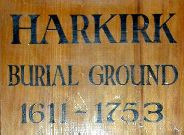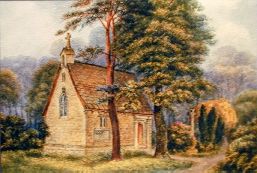
St Mary's, Little Crosby
The Harkirk Chapel
Hidden deep in the woods,
At Little Crosby

 |
St Mary's, Little Crosby The Harkirk Chapel |
 |
|
Click here
to go to the photographs of the Mass
at the Harkirk Chapel held on 14th July 2002
|
|
The following is reproduced from a Mass sheet prepared for the annual Harkirk Mass in 2001 : During the last years of Elizabeth 1st reign, throughout the 17th century and much of the 18th century, many men and women remained true to the "Old Faith", and were refused buriel in their parish churchyards. Often they were buried in fields or gardens. In December 1610, the vicar of St Helen's church, Sefton refused the burial of a local woman, and her relatives and friends interred her body in a shallow grave close by a lane near to some common land. Unfortunately, the body was disturbed and desecrated by hogs which grazed on the common land. William Blundell (1560-1638), of Crosby hall,
heard of this tragedy and in his own words :- The piece of land that he selected was a plot thought, from time immemorial, to have been the site of an ancient chapel, known in those days, as now, as the Harkirk. The first buriel was of an old man called William Mathewson of Little Crosby; it took place on the 7th April 1611: he had been refused buriel at Sefton Church. The last to be buried was a Jesuit priest called Peter Williams who died at Ince Blundell on 26th November 1753, and was buried the following day. All the buriels were recorded in a small notebook by William Blundell and after his death, by members of his family. The notebook exists to this day. In all 131 people were buried at the Harkirk; men, women and children, including 25 priests; and not just locals.
At the time, buriels often took place at night: the use of candles, vestments, prayers and invocations, and other Popish practices were prohibited. The marking of graves with crosses and similar artefacts was banned. This buriel ground was very important to the local community and because of what he had done and other activities, William Blundell became known to the authorities as "an obstinante recusant". In 1630, the Sheriff was instructed by the Court of Star Chamber to destroy this illegal buriel ground. The walls and fences which William Blundell had erected around the site were pulled down, any grave markers and headstones were scattered and broken, and some of the graves were disturbed. But the buriels continued, the last being :-
After this last buriel the Harkirk was almost forgotten and nothing of significance happened until another Blundell, Colonel Nicholas (1811-1894), built a chapel on the site of the Harkirk in 1889. He noted in his journal :- "I built a small chapel at the Harkirk out of the old stones that were lying about the place, to commemorate the site of the old burying ground dedicated to the use of such Catholic recusants during the time of the Reformation as were refused buriel" The chapel was built as near as possible to the centre of the buriel ground; during the excavations a few human remains were found and reburied under the Chapel. Three undamaged headstones were found and built into the north wall near the door. There are very few recusant buriel grounds throughout the country and possibly none so well documented as the Harkirk at Little Crosby. It is a very important element of Catholic heritage. The Friends of St Mary's at Little Crosby, hope that this buriel site and chapel will be a source of inward strength to all who visit, pause a while, and meditate on the significance of it's existance. |
Friends
of St Mary's, Little Crosby.
Copyright: The Friends of St Mary's, Little Crosby, 2017
E Mail : Friends of St Mary's Little Crosby
for all matters relating to the website only
To contact the parish priest, Rev Dunstan Harrington, please write directly
to him at:
74 Edge Lane, Thornton, Crosby, Liverpool. L23 4TG. Tel : 0151 924 1783